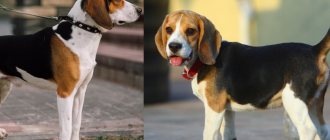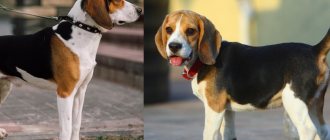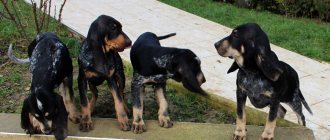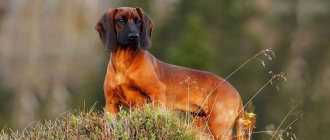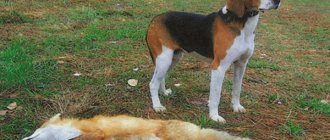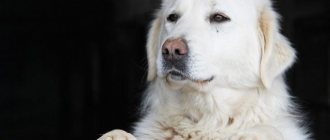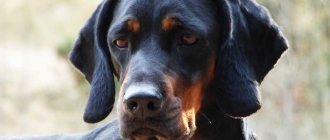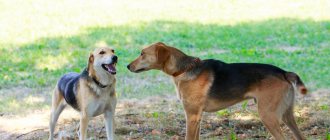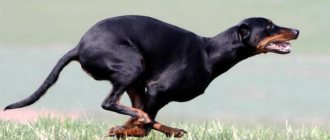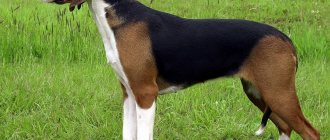Hound dog breeds have always been valued for their hunting qualities and physical characteristics. However, breeders in each country felt the need to develop their own representatives of the breed with unique natural characteristics. This is how the Estonian hound was born - the first breed of dog bred in Estonia. Today these dogs are considered rare and are mainly used in their homeland.
Description of the Estonian Hound breed
Popularity 102nd among 263 dog breeds
Lifespan:
12-15 years
Breed group:
Hounds
Height:
males: 45-52 cm, females: 42-49 cm
Country of origin:
Estonia
Average price:
15-30 thousand rubles
Weight:
males: 15-25 kg, females: 10-20 kg
Latest articles Cat health
Rabies vaccination for cats: choice of vaccine, necessity, schedule 01/22/2022 4 0 0
Selection and adaptation
TOP 20 best cat breeds for families with children 01/22/2022 25 0 0
Vaccinations
In the first year of life, puppies need vaccination 2 times. The first vaccination is given at the age of 6-8 weeks.
If you plan to buy a puppy from a breeder or kennel, vaccinations should already be done.
You will be provided with a puppy along with a veterinary passport, which will have the appropriate mark. The second vaccination must be given at 12 months. Then vaccinations are done once annually.
Before getting vaccinated, you should consult your doctor. There is a vaccine for more than just one disease.
More often there are complex drugs that protect against several diseases. For 10-14 days, the dog is given an anti-worm drug.
Not only the dog’s well-being, but also its health depends on proper vaccination.
Advantages and disadvantages
- Pros:
- endurance, ability to overcome long distances;
- sociability, friendly character;
- kind attitude towards children;
- getting along with other pets;
- neatness;
- quick wit, high intelligence;
- good guard qualities.
- Minuses:
- the need for frequent walking;
- the impossibility of year-round maintenance in an enclosure;
- excessive excitability;
- low popularity of the breed.
Question of price
Differences also appear in cost. Thus, purebred beagles are sold from 30,000 rubles. The price reaches 60-70 thousand rubles for show class. You can get a puppy for 15-20 thousand rubles.
Estonian hounds are sold cheaper - on average for 15,000 rubles. You can find advertisements with a price of 5-7 thousand rubles.
You can buy beagles in the following nurseries:
- https://www.kennel-beagle.rf – St. Petersburg;
- https://www.beaglevista.com – Moscow.
“Estonians” are bred by the following breeders:
- https://sobaki.pro/index.php?m=Poroda&page=Poroda/Pitomniki&id=Esto&pit=2749 – nursery “Nazoro” in Moscow;
- https://iztsarevshchiny.rf – Samara region.
Key facts
Every hunter dreams of having a tireless, fast and smart dog. This perfectly coincides with the characteristics of the Estonian hound breed, which is not inferior in work to greyhounds and piebald representatives. And thanks to its small size and weight, sometimes it has no equal in overcoming all kinds of obstacles. This beautiful, mischievous dog is popular not only among hunters. Often representatives of the breed live at home, turning into family members.
Ready to do anything for its owner, the affectionate, friendly Estonian Hound makes an excellent friend. For all her playfulness and mobility, she cannot be called annoying. At home, the pet understands well the boundaries of behavior, coexisting peacefully next to other animals. The dog is very tolerant of children and poses no danger to them.
Keeping representatives of this breed is easy. They are unpretentious, clean, and shed little. In winter, they should be kept in heated rooms; for the warm season, an enclosure is enough for them. The life expectancy of the Estonian hound is long, on average 12-14 years.
The growth of females and males is different. The male is larger, with pronounced muscles. The female is shorter in height at the withers, more neat in build. The abbreviated name of the breed is Estonian or Estonian. Despite the obvious country of origin, the description of the Estonian hound breed suggests giving truly Russian nicknames, with an emphasis on hunting traditions.
Dogs and other pets
Both breeds perceive other pets only as prey. Therefore, it is not advisable to get another animal. They will chase any cat, hamster, or parrot and dream of killing it as a victim. The only difference between the two dogs is that a beagle can be trained to be wary of another type of animal, while a hound cannot. If a beagle lives in the same room with a cat from birth, then he will be able to imagine her not as prey, but as a friend. The Estonian hound, even in puppyhood, will hunt for any small animals, since its instincts are more developed than those of the beagle.
History of the origin of the Estonian hound
The breeding of hounds in Estonia began in the 50s of the 19th century. At first they crossed Russian and Polish hunting representatives, then they began to experiment with pets brought from England. This mixture led to the emergence of Russian-Polish, Russian-English breeds, common in the Baltic states.
The situation changed in 1934, when new hunting rules replaced the old ones. They were necessary due to a sharp decline in the population of certain animal species. For example, the number of roe deer was on the verge of complete extinction.
According to the introduced requirements, the use of dogs was allowed when hunting only medium or small fur-bearing animals. The hound was supposed to be small, no higher than 45 cm at the withers. That’s when the active process of breeding a breed with short stature and excellent working qualities began. Baltic canine specialist Sergei Smelkov led this work, which lasted two decades and led to the creation of a new type of hunting dog.
Experts have begun crossing the English beagle with the shortest breeds of local dogs. Breeders considered it important to preserve not only the small size. The appearance of a hare hunter attracted them very much due to the strong, dense paws that were suitable for the snow-free Baltic winters. Light-footed dogs did not cope well with hunting trails, which became hard as stone.
Unfortunately, not all the qualities of the beagle suited Smelkov. The English breed has a rough, muffled voice, the instinct of pursuit is formed quite late, and the speed of pursuit of the animal is low. This prompted an Estonian dog handler to turn his attention to the Swiss hound. Although her paws were not strong enough, she had a clear voice and began working on the beast early.
There are interesting facts that as a result of selection work on breeding short individuals, fairly large breeds of dogs with a height of 52-60 cm appeared. And the Estonian dog itself was of different types in the early 40s of the last century.
In 1947, all fifteen republics of the USSR were obliged to present their own breed of dogs. By that time, there were over 800 hounds in Estonia, the result of a mixture of representatives of the Estonian, English and Swiss lines. In 1954, 48 of them took part in the hunt for fur-bearing animals. A special commission from the USSR Ministry of Agriculture monitored the process, then recognized a new breed, named the Estonian hound according to its country of origin.
Now they are popular in the Baltic countries, Russia, and Finland. Despite this, the International Canine Federation, for objective reasons, refuses to recognize the breed. At the same time, minor changes related to color were made to the standard adopted in 1959.
Comparison of working qualities of dogs
Despite their predisposition to hunting, in fact, dogs differ strikingly in their working characteristics. Estonian hounds love to hunt animals such as hare, lynx, and fox. They can also perfectly track roe deer, small wild boar and birds. Many hunters who use this breed to catch prey argue that a hound cannot be trained to search for animals by following hoof tracks.
It is much easier to pick up than a hare's trail. In the future, a dog accustomed to this method will hunt only ungulates. Beagles are excellent at hunting hares, rabbits and other large rodents. They will not be able to handle prey larger than them, unlike Estonian hounds. The latter love to track and drive prey on their own. But beagles prefer the pack method of working.
Appearance of the Estonian hound
General impression
The Estonian Hound is a short dog with well-developed muscles and a strong, proportional build. She has elegant features, distinguishing her from the big-boned beagle with which some people confuse her. Indeed, in a photo it is easy to confuse an Estonian hound and a beagle, but in life their differences are striking.
Head
The skull is quite elegant, slightly wide, it smoothly, without a sharp break, passes to the elongated muzzle. The wide nose varies from black to brown, depending on the color of the animal. The brow ridges are clearly defined, the cheekbones are without obvious bulges. The Estonian's jaws are well developed, the teeth are white and large.
Neck
The muscles of the hound's medium-length neck are clearly visible. There are no skin folds.
Torso
The body is small but strong, with good muscles and a lean constitution. The height at the withers is noticeably less than the length of the body.
Forelegs
The paws are strong, dry, with developed muscles, look parallel, without bends. Their length is approximately equal to half the height of a hound. The pasterns are almost vertical.
Hind limbs
The hind legs are very powerful and bony. The thighs and shins are almost the same length. While running, the knee joints should not be twisted. The hocks are of medium length and vertical.
Tail
The tail is saber-shaped, tapering to a tip, and covered with thick, coarse hair. When moving, it does not rise above the back.
Movements
Fast, sometimes fussy. The dog is very agile, quickly picks up speed, and easily jumps over obstacles.
Wool
The Estonian Hound is the proud owner of a thick coat that is hard to the touch. Hair length is the same on all parts of the body. There is no undercoat. Moderate shedding occurs seasonally.
Color
This breed is characterized by a black and piebald color with reddish markings and blush. Possible brown-piebald, crimson-piebald color, reminiscent of a blanket put on a dog. The legs and tip of the tail of the Estonian remain completely white. This color is found on the head, chest, belly, and neck of a thoroughbred individual. In general, the colors of the Estonian Hound are not very diverse.
Size
The weight of the Estonian Hound varies from 11 to 20 kg. The height at the withers depends on the gender. The height of Estonian hounds for males is 45-52 cm, for females it is smaller, about 42-49 cm.
The size of the Estonian Hound allows you to keep the dog in a small apartment. At the same time, do not forget about good physical activity.
Owner reviews about dogs
Based on the reviews of those who own these two breeds, we can conclude that each dog should be selected depending on the character of the owner. People who have a beagle as a pet are active and cheerful individuals who feel the need for the same dog. They note that the beagle makes their life more fun, joyful and energetic. With such a dog they are never bored.
The Estonian Hound is a devoted, persistent and faithful friend who will feel his owner and adapt to his life. The owners of these dogs claim that a more reliable dog than the Estonian hound cannot be found. This breed is very popular with calm, reasonable people. They note that with such a friend they feel comfortable anywhere, because due to their disposition, the Estonian Hound is perfect for people who travel frequently.
Personality of the Estonian Hound
Despite the high hunting qualities, assertiveness and mercilessness when catching animals, this breed of dogs is kept as pets. They show great love for their owners and friendliness towards others. The Estonian woman leaves all her anger for hunting, but at home she becomes affectionate, devoted, and obedient. The kind, patient nature of the Estonian hound allows it to be kept in an apartment where small children live. The hound takes their pranks calmly. But the most important thing for the Estonian will be the owner, perceived as the leader of the pack.
Other animals living nearby are considered her friends if they grew up together. When not a puppy, but an adult dog comes into the house, it will take a lot of time to eliminate conflicts and clashes that occur with other pets. Cats will especially get it.
The Estonian Hound is a very clean dog, keeping it in an apartment will not be a problem for the owner. You just need to remember about your pet’s ebullient energy, which it will expend on long walks. Country houses are still considered the best habitat, where the animal is kept indoors in winter and outside in an enclosure in summer.
Those who are suited to the hunting qualities of a hound note the early manifestation of working skills. By six months, she begins to sniff and pick up the animal's trail. By the year they show all the excitement and aggressiveness, bringing good trophies. The external characteristics of the pet are their advantage, not giving the game a chance to escape from the pursuer.
Your pet will be an excellent watchman thanks to its intelligence, courage and bravery.
Character and hunting qualities
Estonian dogs are very calm and even during the rutting season they can stop at the command of their owner. Animals are not at all aggressive towards people and are attached to family members. For this reason, today dogs are increasingly used not as hunting dogs, but as ordinary pets.
Such use of hounds is, of course, permissible, but in this case the pet loses its hunting qualities. Because of this, the animal's offspring may be less focused on hunting.
The Estonian Hound and children get along great. Even if a small child gets carried away with the game and accidentally harms the dog, the animal will not react aggressively to this. Also, representatives of the breed get along well with their relatives, because they were previously kept in packs. But it is better not to keep them with cats; hounds will perceive them as prey.
Despite being highly people-oriented, the nature of Estonians is such that they are distrustful of strangers. Therefore, the animal needs early socialization: the puppy must be taken to public places so that it can get used to large crowds of people. Otherwise, the dog may grow up fearful.
The physical qualities of the dogs are at a high level. They have a good sense of smell, stamina for a long rut and great strength. Therefore, representatives of the breed are suitable not only for hunting small game. They are often taken to drive larger prey: elk, wild boar, etc. Taking into account the preferences of hunters, breeders bred a dog that can swim well. Therefore, in the hot season, an animal may ask to go into a pond as soon as it sees water.
Education and training
The Estonian Hound is easy to train and understands commands mostly immediately, without numerous repetitions. A trained dog, in addition to the orders “Sit!”, “Lie down!”, “Paw!”, responds well to the words “You can’t!”, “Voice!”, “Near!”. A dog of this breed quickly responds to affection, so it is very easy to spoil it. Begging and lying on the bed are problems that arise immediately after permission from the owner. How to wean them off is up to everyone to decide for themselves. The main thing is not to be rude and be patient.
Raising and training the Estonian Hound should begin gradually. The puppy is trained from a very early age. First of all, you need to instill in him:
- the skill of going to the toilet at a certain time;
- the habit of responding to your nickname;
- carry out simple commands from the owner.
Training should be carried out in a playful way, moving from simple to complex, rewarding for achievements.
You shouldn’t forget about the hound’s specific skills either. From a young age, your pet's hunting instincts should be developed. Experienced owners take the puppy into the forest from the age of two months to get acquainted with the surrounding smells; by the age of six months, they are taught to navigate the area and return even from afar on the first command. Exercises to chase and locate the animal can be carried out at any time of the year.
It is better to start training your dog to hunt in the fall on blacktops - land not yet covered with snow. But don’t forget to practice your skills in winter, summer and spring. Only regular practice of specific skills gives positive results.
Forcing a hound to work at full capacity for up to a year is harmful. Overexertion is bad for your health and can lead to heart problems.
Key points in training
Raising an Estonian Hound requires a lot of patience as they can be stubborn at certain points. To avoid troubles in training, you need to start training the puppy from the very first day, as soon as the pet got into the house.
The nervous system of hound dogs has a very interesting feature that inexperienced owners may confuse with disobedience.
When a dog chases fur, nothing should throw it off the scent. This has been developed genetically for many generations, specifically to improve working qualities.
In everyday life, this feature can interfere. The dog sniffed the smell and no longer “heard” the owner. This is not a manifestation of bad behavior, but the principle of the central nervous system; you cannot punish a dog for this. It is impossible to completely get rid of this property, but it can be corrected by practicing from early childhood.
Read about how to properly train a dog in the article: “Training a puppy: effective methods from dog handlers, learning commands at home.”
Health and diseases of the Estonian hound
Possible diseases
Estonians can safely be classified as individuals with strong immunity. They rarely get sick, especially when properly maintained. Vaccinations given on a schedule from birth will only improve your dog’s health.
Diseases that occur in these animals include arthritis, dislocations, ligament ruptures and joint damage. This occurs due to the stress on the paws and excessive physical stress experienced during hunting. Ear infections can be common and occur in all breeds with floppy ears. Less common are eye diseases: cataracts, conjunctivitis, glaucoma, retinal detachment.
Ticks, carriers of piroplasmosis, are dangerous to the lives of hounds who spend their time actively. The best way to protect yourself from this scourge is to use modern medications: tablets against blood-sucking parasites, drops on the withers, special collars, sprays.
In any case, the owner needs to carefully inspect the dog’s coat after a hunt or walk. If she becomes lethargic, refuses to eat or drink, or her mucous membranes turn pale, you should immediately contact a veterinarian. Delay can lead to serious health consequences and even death of the animal.
Reproductive health
Full maturation of Estonian hound bitches ends at the age of one year, when the first heat begins. Before estrus, her behavior changes: she becomes too stubborn, restless, and may refuse to eat. When bleeding occurs before the age of seven months, you should consult a doctor. If the owner does not plan to breed puppies, it is better for the girl to be sterilized.
The dog's pregnancy will be healthy if the bitch is mated starting from 20 months, that is, after the third heat. Males are bred from the age of two.
Mating
Only completely healthy individuals over 18 months of age are allowed for breeding. Later it’s possible, earlier it’s absolutely impossible. For vyzhlovki this is the 3rd or 4th sexual heat. For survivors, the main condition is age; they are always ready for insemination.
Mating is carried out no earlier than the 10th day of estrus and no later than the 18th . To be sure, you can take a special test at a veterinary clinic to determine readiness for mating.
Features of feeding and diet
The small size of the animal does not mean at all that the amount of food will also be small. On the contrary, feeding should be approached responsibly from a very early age. When answering questions about how many times to feed, we must take into account that a puppy needs to consume 140 Kcal per kilogram of weight, an adult pet - about 75 Kcal per 1 kg, and an elderly dog - 35 Kcal.
The dog is usually not picky when it comes to food. The owner will not have to think long about what to feed her. Natural or dry food is suitable, the main thing is to remember that the food should be nourishing, high-calorie, and meet the age and needs of the pet.
It is better to start feeding puppies with cottage cheese, low-fat fermented milk products, and boiled meat. It is recommended to give boiled eggs twice a week.
Adult dogs eat twice a day. Food should be slightly warmed. Several times a month they should be given raw or boiled vegetables, fresh lean meat, and low-bone fish. Carrots are especially beneficial for dogs’ eyesight; you can add grated raw potatoes to the diet.
It is not advisable to offer chicken, pork, or beef bones to your dog. Barley, oatmeal, and pearl barley are preferred. Fermented milk products in the diet of an adult pet should be low in fat. Of course, we must not forget to change the water to ensure proper drinking regimen.
Nutrition
Estonian hounds are not picky eaters. The price of food will not be too high, since the dog is relatively small, as can be seen from the photo. She is not prone to overeating. But intense exercise requires a lot of energy.
For the development of skeleton and strong muscles, sufficient amounts of calcium and protein are necessary. If you prefer natural nutrition, your diet should contain the following components:
- dairy products;
- meat;
- cellulose;
- fats;
- fat-soluble vitamins.
If you plan to feed your dog food , give preference to a special brand for hunting dogs. It takes into account all the features of their life, and its price is optimal.
If you still haven't decided what to feed your pet, check out the following article:
Don't make the mistake of combining natural and dry food. This can lead to health problems for your pet.
They stop feeding the dog a day before the hunt. During this period, she is given only clean water.
Care and maintenance
Small size, short hair and lack of undercoat make it possible to keep the Estonian both in an apartment and in a country house. Although the pet is very mobile, there is little damage from it. All his energy goes into hunting or long walks with his owner. Beyond the threshold of a house or apartment, he turns into a well-mannered dog.
Reviews from owners indicate that the dog has little conflict. With proper upbringing, there are also no problems with scratched furniture, chewed shoes, or wires.
Hounds are very clean, so there is no need to bathe them more than once a month. In the summer, an excellent substitute for washing in the bathroom is swimming in ponds, which they love to do.
There are no particular problems with shedding either. The dog should be brushed more often using a special device for short-haired breeds. She enjoys this procedure.
The activity of the Estonian hound does not mean at all that it will run like a clockwork. It is pleasant to walk, jog or ride a bike for different distances.
You should walk your pet more than twice a day. Walking four times a day is considered ideal: in the morning, at lunch, after dinner, before bed. It is useful for Estonians to walk up to 5 km a day to maintain health and good physical shape. It is desirable that the dog has the opportunity to run without a leash at different speeds.
But the owner should move with caution near busy roads. A hound may be interested in the trail of another animal, not paying attention to passing cars. This can lead to dire consequences.
You can keep a hound at home or in an enclosure. During the cold season, the dog must live in a heated room.
The owner decides for himself how to feed the animal, because it tolerates natural, dry food and homemade food well. Do not forget about special vitamin complexes and fish oil, which are necessary to maintain good dog health.
How to distinguish between puppies of two breeds
There are almost no differences between 2-3 month old cubs. All puppies are well-fed, cute, and have a similar appearance.
It is possible to distinguish a beagle puppy from an Estonian hound only at 5-6 months, when the breed's characteristics appear. But they usually take away babies up to 3 months old.
Therefore, when buying a puppy, you need to:
- see both parents live, especially the hatchling: a phrase like “mom is now at the dacha/walking with her husband/hunting, but we have a photo” is an excuse from unscrupulous breeders;
- check documents: pedigrees, passports, kennel registration documents, breeding permits, certificates of victories in exhibitions - for “Estonians” the latter must be field tested;
- invite an experienced dog handler or breeder - for the average person there are no differences in the breeds.
Tips for choosing a puppy
The Estonian hound cannot be called a popular breed in Russia. Not everyone who wants to buy them knows exactly what it looks like. Scammers take advantage of this by passing off puppies of other breeds as Estonian.
Experienced owners recommend making a choice in specialized nurseries, carefully studying the baby's pedigree. For those who are keen on hunting, it is important to find out information about the working qualities of the parents of the future companion.
If mom and dad were residents of apartment sofas, then most likely their child will not be able to fully develop the instincts for baiting a hare or other fur-bearing animal. The price in nurseries is high, but this will help avoid disappointment from a bad purchase.
When choosing a puppy, you need to pay attention to:
- correct jaw bite;
- strong physique;
- thick paws;
- clear dark eyes;
- wet nose;
- good physical activity;
- absence of defects in the bone structure.
It is best to take it at the age of 1-4 months. This will ensure a less painful adaptation to new living conditions. It is preferable to choose it from a bitch between two and nine years old. It is during this period that females give birth to the healthiest offspring.
It will be successful to buy a puppy from an experienced hunter who is ready to share the strong ones left over from mating. It is clear that he keeps the best for himself, but the rest of the Estonian hound puppies will most likely not disappoint the buyer. He will also tell you how to choose a worthy baby and what you should pay attention to. The disadvantage of such transactions is the lack of documents confirming the pedigree of the hound.
How to choose a puppy
Before choosing a dog, you need to decide what place it will take in life. A hunter needs to look for good working nurseries. For a person who is simply looking for a companion, it is not necessary for his parents to have field diplomas.
An exceptional condition is the purchase of a healthy pet. It’s good if the breeder can show documents about the absence of genetic diseases in the parents of the future pupil. All veterinary measures taken must be noted in the passport.
Buying a puppy that is barely 4-6 weeks old is highly not recommended. The puppy must have time to fully go through the first stage of socialization with its mother and littermates.
The ideal age for moving to a new home is 10 – 16 weeks of age.
How much does an Estonian hound cost?
The cost of puppies depends on the needs of the future owner. If it is purchased as a pet, you can consider ads from 5 thousand rubles. However, you should definitely look at the baby’s mother. The seller usually provides this option. This is easier to do by buying a puppy from a specialized nursery, where the price of an Estonian hound is slightly higher than that of a private seller.
A hunting specimen costs much more. This amount reaches 30 thousand rubles. When making a choice, be sure to find out about the working qualities of your parents and their achievements.
Do you like the article? 0
Where to buy and price
Puppies can be purchased either secondhand or from licensed kennels. In the first case, the price will be significantly lower; the baby can cost 3,000-6,000 rubles. For an animal with documents they can ask for 10,000-15,000. Among the nurseries engaged in breeding the breed in Russia, the following stand out:
- From Tsarevshchina (Samara);
- Nazoro (Moscow).
The price of a puppy received from titled parents can reach 30,000 rubles.
Estonians are versatile dogs, acting both as a pet and as a formidable beater of game. But it is important to remember that the animal has pronounced hunting qualities, so it needs to receive great physical activity. If the owner is willing to devote a lot of time to the pet and raise it, then this is a suitable option.
Breed characteristics
- Aggressiveness: Not aggressive ( Total score
1/5) - Activity: High ( Overall score
4/5) - Training: Easy ( Overall score
4/5) - Shedding: Low ( Overall score
2/5) - Need for care: Medium ( Overall score
3/5) - Friendliness: Friendly ( Overall score
4/5) - Health: Good ( Overall score
4/5) - Maintenance cost: Average ( Overall score
3/5) - Attitude towards loneliness: Short periods ( Total score
2/5) - Intelligence: Smart ( Overall score
4/5) - Noise : Low ( Overall score
2/5) - Security qualities: Average ( Overall score
3/5)
Who is better to have
A comparison between the Estonian hound and the beagle is impossible without the purpose for which the dog is bred.
If you need a companion, a family pet, or just an optimistic friend, it’s better to get a beagle. Plus, its size is smaller than that of the “Estonian”, making it easier to keep a pet in an apartment. The Estonian Hound is a serious hunting dog. Non-hunters are not advised to own one. Temperament, the desire to track and drive animals are the key differences of the breed.
Without work, “Estonians” are withering away. Often, after a year or two, inexperienced owners are looking for someone to give their pet to. It is difficult to part with a pet, but it is even more difficult to find a hunter who wants to take an adult, untrained dog.
Moreover, you need to remember that English beagles and Estonian hounds are not easy to train. If you can’t make circles in fields and forests for 3-4 hours every day, you should take a closer look at calmer dogs.
Briefly about beagles
Beagles are one of the oldest breeds of hunting dogs: small hounds similar to them appeared in the 15th and 16th centuries . There is no exact information about where they came from, but there are several versions regarding their origin.
Thus, it is believed that the first hounds appeared in Ancient Greece. The Romans, having adopted the experience of using such dogs, brought them to Britain, where they crossed with local breeds for a long time.
According to another version, England had its own breeds of hound dogs even before the Roman invasion, in particular, the famous white hounds of Pwyll, Prince of Wales, who was a contemporary of King Arthur.
Many researchers believe that beagles originated from these dogs..
In the Middle Ages, it was a common custom for dogs to be transported to the hunting ground by placing them in special baskets attached to saddles, which is why small hounds were valued.
Basically, they were then used to hunt rabbits, although beagles can hunt any other small game.
As a breed, they were formed by the middle of the 18th century, but the ancestors of modern beagles were a pack that belonged to Parson Honeywood, who lived already in the 19th century .
The first breed clubs appeared in the 1880s in America. The modern breed standard was approved only in 1957.
The Beagle is a strong and muscular dog of medium size (approximately 33-40 cm at the withers) with short, self-cleaning hair. His head is of noble shape, with a convex forehead and well-defined stop.
The nose is large, the ears are quite long, low-set, falling along the cheekbones.
The muzzle is not narrow, with clearly visible jowls. The body is compact, with a medium-length neck, broad chest, strong back and muscular limbs.
The tail is quite thick, of medium length, set high. When excited it can be raised almost vertically, when calm it can be lowered.
According to the standard, beagles are allowed any color typical of hounds, with the exception of red-brown.
